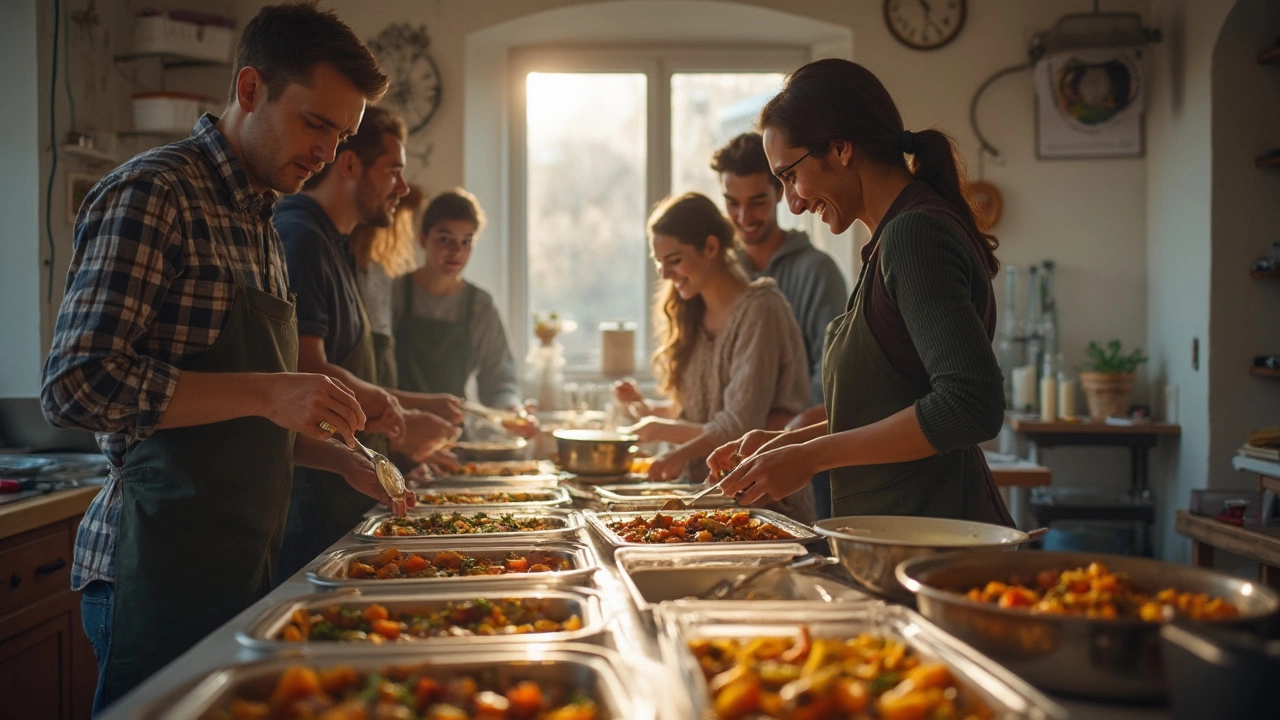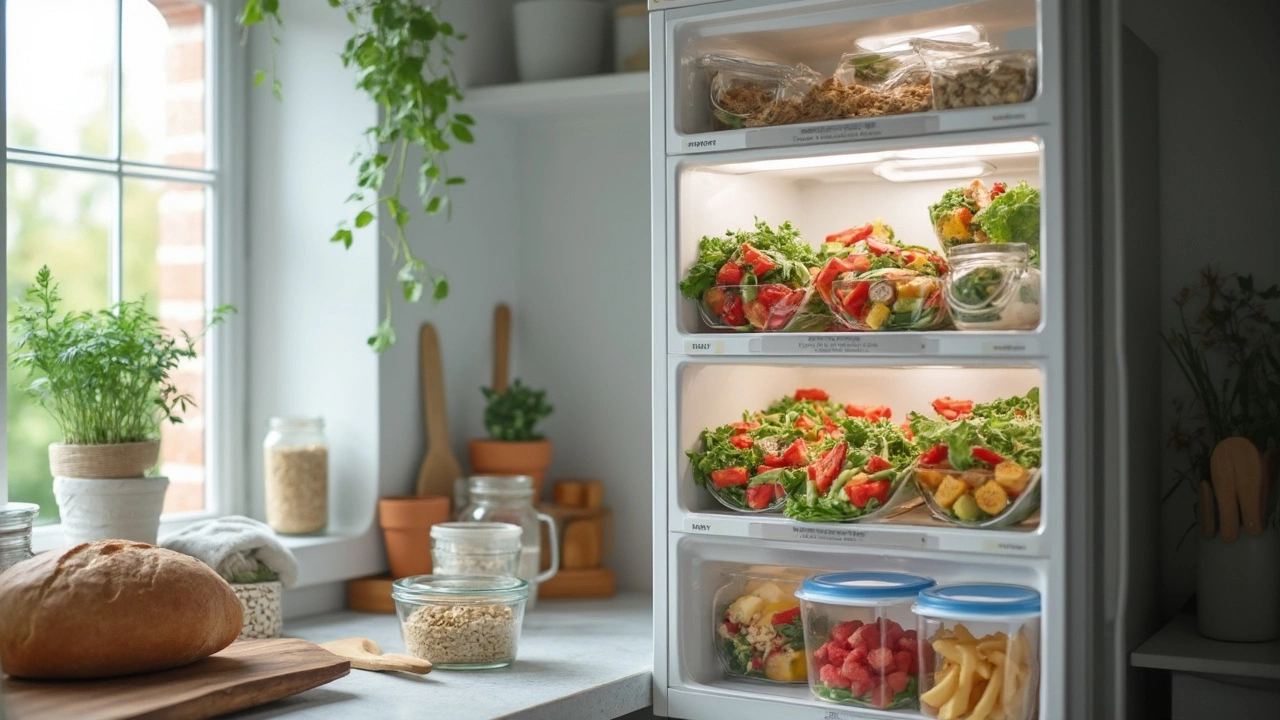If meal prepping has ever felt like a chore, you’re not alone. The secret to meal prepping without losing your sanity? It all comes down to three things: planning, batch cooking, and storing smarter. Nail these, and you can save hours every week without ending up with bland leftovers or sad, wilted salads.
Start with a super clear plan. Whipping up meals from random ingredients rarely works. Sit down once a week and pick your recipes. Make a simple chart if you like visuals—Monday: chicken stir-fry; Tuesday: veggie bowls; Wednesday: pasta—done. This takes away day-to-day guesswork and those last-minute, expensive takeout runs.
- Why Planning Is Your Superpower
- Smart Shopping: Skip the Guesswork
- Batch Cooking Made Easy
- Storage Hacks for Freshness
- Staying Motivated and On Track
Why Planning Is Your Superpower
If you want to crush meal prepping and not end up eating the same boring thing every day, planning seriously makes all the difference. A study from the International Journal of Behavioral Nutrition showed that people who plan their meals are 2.5 times more likely to eat healthy food and stick with their goals compared to folks who wing it. That’s no small upgrade.
Here’s the thing: most people quit meal prepping because they run out of ideas or get stressed shopping. A plan takes that all off your plate (pun totally intended). You walk into the store knowing exactly what’s on your list. You’re not just saving yourself from panic-buys and wasted veggies—you’re also saving money and time. One simple schedule could keep $30 to $50 in your pocket each week, according to a 2023 USDA household survey. That adds up fast.
So, what does solid planning actually look like? Try this process:
- Pick 2-4 recipes you’re actually excited to eat (think: taco bowls, sheet pan veggies, or breakfast burritos)
- Decide how many portions you need. Multiply by the number of days you want to prep for—don’t overdo it or you risk burnout
- Make a master grocery list. Separate by section—produce, meats, pantry, frozen—to make shopping less painful
- Block out 30 minutes (tops) once a week for this. Put it on your calendar and treat it like a meeting
Here’s a quick look at how planning pulls everything together:
| Without Planning | With Planning |
|---|---|
| Impulse grocery trips | One focused shopping trip |
| Forgotten ingredients | Complete grocery list |
| Food waste | Everything prepped and used |
| Stress at dinner | Dinner ready in minutes |
The takeaway? Small planning tweaks up front keep the whole week smoother. You waste less food, you eat better, and you actually look forward to meals because they fit your taste. Pretty solid trade for 30 minutes once a week.
Smart Shopping: Skip the Guesswork
If your grocery trips are a confusing blur or you always come home with too much (or too little), you’re not getting the most out of meal prepping. Smart shopping saves money, cuts food waste, and really speeds things up. Here’s where the magic happens: a solid shopping list based on a clear plan.
First, match your grocery list to your meal plan. Check your recipes and note exact amounts you’ll need. It keeps you from buying three bags of carrots when you only need one. Better yet, group your list by store sections: veggies, proteins, grains, dairy, pantry staples.
- Start with your fridge and pantry. Note what you already have and cross off things you don’t need to rebuy.
- Choose recipes that use overlapping ingredients. For example, if two meals call for bell peppers, buy in bulk and save money.
- Stick to your list when you’re in the store. Extra shopping almost always leads to wasted food or impulse snacks you’ll regret later.
Buying in bulk pays off, especially for basics like brown rice, oats, or canned beans. A USDA study found that people who shop with a list spend about 23% less than those who go without. That’s a chunk of change back in your pocket over a year.
Sometimes it helps to spot-check if you’re really getting good value. Here’s a quick look at common savings when meal prepping with a plan instead of winging it:
| Item | Random Buys (per week) | Planned Buys (per week) | Weekly Savings |
|---|---|---|---|
| Produce | $24 | $16 | $8 |
| Proteins | $30 | $20 | $10 |
| Snacks | $12 | $4 | $8 |
It comes down to this: Meal prepping actually starts at the store. Budget better, buy only what you know you’ll use, and skip midweek trips that throw off your routine. Your wallet and your future self will thank you.

Batch Cooking Made Easy
Batch cooking is the easiest way to get the most out of your time in the kitchen. Instead of cooking every single night, you make bigger batches of food once or twice a week, then portion it out. You’re not just saving time—you’re cutting down on dishes, grocery store trips, and daily decision-making, too.
Want some proof it’s worth it? According to a study by the International Food Information Council, people who meal prep with batch cooking eat more fruits, veggies, and home-cooked meals. Plus, batch cooking can cut your total weekly meal prep time by almost 50% compared to prepping each meal from scratch.
Here’s how to keep batch cooking straight-up simple and stress-free:
- Pick a handful of recipes that use similar ingredients—think roasted chicken that’s good in salads, wraps, or grain bowls.
- Use a big pan or slow cooker, and double or triple recipes where it makes sense.
- Start with foods that hold up well in the fridge or freezer: rice, quinoa, stews, grilled veggies, braised meats, and pasta bakes.
- Don’t forget to season and sauce meals after heating, so nothing tastes dry or bland.
- Let hot foods cool before sealing and storing, so you don’t end up with soggy leftovers.
To make things even easier, here’s a quick batch-cooking chart for two popular staples you can knock out in under an hour:
| Food | Batch Size | Cook Time | Fridge Life | Freezer Life |
|---|---|---|---|---|
| Brown Rice | 8 cups | 40 min | 5 days | 2 months |
| Chicken Breast | 6 pieces | 30 min (oven) | 4 days | 3 months |
If you struggle with taste burnout, try splitting batches in half and adding different flavors or sauces halfway through. For example, make a big pan of shredded chicken, then season half with taco spice and the rest with lemon pepper.
Batch cooking isn’t just about dumping ingredients into a pot. The real magic happens when you plan how you’ll use leftovers, so no one feels like they’re eating the same thing all week. That’s how you stick with meal prepping for the long haul.
Storage Hacks for Freshness
Nobody likes a soggy salad or dry chicken by Thursday. Getting your storage game right is where your meal prepping pays off most. Let’s be real: the way you store your food makes all the difference if you want meals to taste like they were made today.
First, ditch those flimsy plastic bags. Invest in quality glass or BPA-free plastic containers that seal tight. Airtight lids stop air from wrecking your food’s texture and taste. If you’re storing salads, put the dressing on the side to keep your greens crisp. For stuff like pasta or cooked grains, adding a tiny splash of water before reheating helps keep them soft instead of drying out in the fridge.
Your fridge setup matters, too. Place ready-to-eat meals on the top shelf where you’ll see them, and use the crisper drawers for prepped veggies. Stack containers so the ones you need first are right up front. If you’re all about saving time, use clear containers so you can spot what’s inside—no more mystery leftovers.
Most cooked foods stay fresh for 3-5 days in the fridge if stored right. If you need your prep to stretch further, freezing is your friend. Always let hot food cool before sealing and freezing so you don’t trap steam and cause soggy, icy results. Label every container with the date. That way, nothing gets lost in the back, and you’ll always know what’s good to grab.
| Type of Food | Fridge | Freezer |
|---|---|---|
| Cooked Chicken | 3-4 days | 2-6 months |
| Cooked Veggies | 3-5 days | 2-3 months |
| Grains/Pasta | 4-5 days | 1-2 months |
| Soups/Stews | 3-4 days | 2-3 months |
| Fresh Cut Fruits | 2-3 days | 8-12 months (if frozen) |
Don’t forget: Not all foods freeze well. For example, raw potatoes and leafy greens usually get mushy or lose flavor after thawing. Stick to freezing sauces, stews, and cooked proteins for best results.
To cut down on food waste, keep a running list on your fridge of what you’ve prepped and when you did it—just a sticky note works. Not only does this keep meals safe to eat, but it also saves you money and trips to the store. These storage hacks might look small, but they’re a real game changer if you want fresh, tasty meals all week long.

Staying Motivated and On Track
Sticking with meal prep is actually more about mindset and routine than it is about cooking skills. Motivation can dip, especially after a hectic week or when meals feel repetitive. Let’s keep things interesting and practical, so you don’t fall back into old habits.
One easy trick: set clear, specific goals. For example, "I want to pack lunch for work 4 days next week," instead of just "I’ll eat healthy." Track your progress—there’s a reason fitness apps have streaks and check-ins, because seeing your own progress boosts motivation big time. Research shows that people who monitor their habits are twice as likely to stay consistent.
Switch things up if you hit a rut. Add one new recipe each week, try different veggies, or grab that sauce you’ve never tried before. If planning feels like a chore, consider themed days (like Taco Tuesday or Stir-Fry Friday), so there's always something you look forward to.
- Prep with a friend or loved one: doing this together can keep you accountable and actually make it fun.
- Keep your kitchen organized: knowing where everything is cuts down on stress and saves time, making it less likely you'll bail on your plan.
- Reward yourself for hitting meal prep goals. Treat yourself to a coffee, a movie night, or anything that feels good as a little nudge to keep going.
If you start skipping meal prep, don’t beat yourself up. Look for patterns—was it a packed Sunday or a week with late nights? Adjust your schedule instead of giving up. Even prepping just a few items, like breakfast or snacks, counts as winning.
| Motivator | Impact on Meal Prepping |
|---|---|
| Setting Specific Goals | Twice as likely to stick with routine |
| Tracking Progress | Boosts motivation and accountability |
| Adding Variety | Makes meal prepping enjoyable |
Most people quit meal prepping because they lose interest or feel unprepared when life gets busy. The real win is building meal prepping into your weekly routine until it’s just part of what you do. That’s how meal prepping becomes second nature, and you actually look forward to it. Remember, even small wins count—progress over perfection, always.










